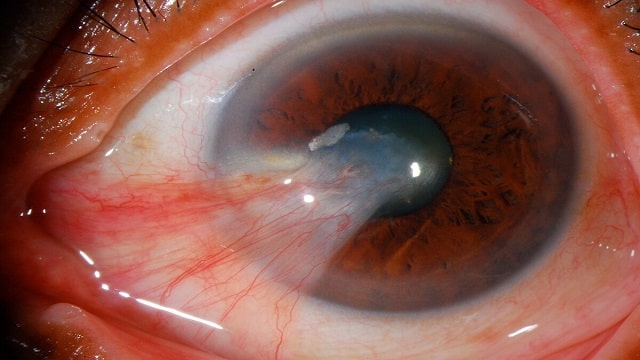Pterygium
Pterygium is an eye disease that occurs due to the growth of a pink, triangular tissue membrane that appears on the white part of the eyeball. This condition is also known as surfer‘s eye.
Typically, this condition begins on the cornea near the nose and can grow to the pupil (the black part of the eye). This condition is usually only found in one eye.
However, if you experience it in both eyes, this eye disorder is called pterygia. This disease can cause discomfort and trigger itching. If not treated immediately, this condition can increase the risk of closed pupils and impaired vision.
Symptoms of Pterygium
This disease develops slowly. At the beginning of the appearance of pterygium, you will not experience any symptoms. However, symptoms will be felt more as the condition worsens.
There are several symptoms that sufferers often experience in the early stages of its development, such as:
- A pink line appears on the white of the eye.
- Red and irritated eyes.
- Dry eyes accompanied by itching and a burning sensation.
- Feeling like there is sand or dust in the eyes.
- Eyes that water more often.
- The vision became a little blurry.
Worsening symptoms are characterized by the growth of a membrane that increasingly covers the cornea and impaired vision.
Pterygium Risk Factors
Avoid various risk factors that can trigger this disease, such as:
- Spending too much time outdoors during the day.
- Eyes exposed to dust, sand, and air pollution can cause eye irritation.
- Dry eyes.
Causes of Pterygium
It is not yet known exactly what causes pterygium. However, too much direct exposure to ultraviolet light is thought to be the cause of this condition.
There are several theories that try to explain the pathogenesis of pterygium. For example, geographical variations affect the incidence of pterygium, which is shown by most studies that have been done. This is based on the higher incidence of pterygium in countries closer to the equator.
The increased prevalence of pterygium is thought to be due to the damaging effects of ultraviolet radiation, particularly UV-B radiation, which affects people in equatorial regions. The hypothesis is that this radiation causes mutations in the p53 tumor suppressor gene, thereby facilitating abnormal proliferation of the limbal epithelium.
Apart from direct exposure to sunlight, eye irritation that is not treated properly can also trigger pterygium.
Diagnosis of Pterygium
A doctor can diagnose this condition based on a physical exam using a slit lamp. This lamp allows the doctor to see a person’s eye with the help of magnification and bright lighting. Additional tests include:
- Visual Acuity Test. This test involves reading letters on an eye chart.
- Corneal Topography. This medical mapping technique is used to measure changes in the curvature of the cornea.
- Photo Documentation. This procedure is done by taking pictures that aim to track the growth rate of the pterygium.
Pterygium Treatment
If the symptoms of pterygium are still mild or still in the early stages, doctors will generally prescribe medication to reduce irritation or redness in the eyes. Medication can be given with steroid eye drops, artificial tears, and so on.
However, if the pterygium has reached an advanced stage and disturbing symptoms are found, such as impaired vision, the doctor will recommend surgery to remove this abnormal tissue growth and remove it. After that, conjunctival tissue or placenta can be used to fill the empty space where the pterygium lesion was.
Pterygium Complications
If left untreated, this condition can trigger severe scarring of the cornea. Scarring can increase the risk of vision loss.
Pterygium Prevention
Prevention of pterygium disease can be done by using sunglasses with lenses that can block 99-100 percent of UV A and UV B every day when going outdoors and the weather is hot.
Don’t forget to use head coverings, such as hats, which can protect your eyes from direct exposure to sunlight.

